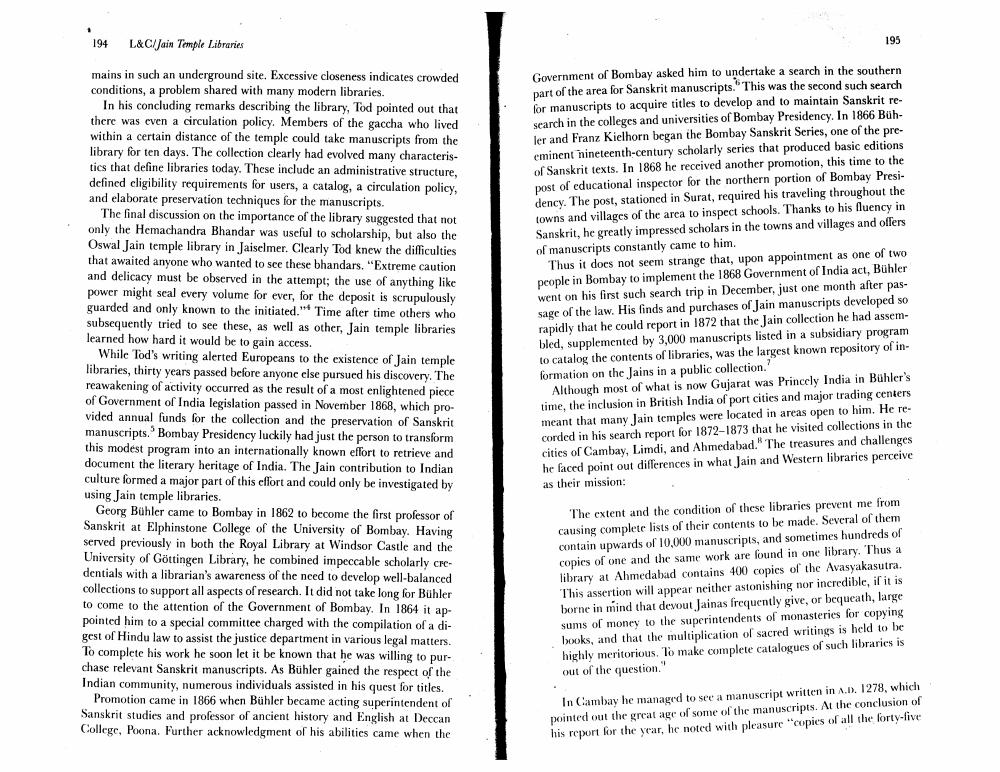Book Title: Western Discovery Of Jain Temple Libraries Author(s): Donald Clay Johnson Publisher: Donald Clay Johnson View full book textPage 4
________________ 194 L&CI Jain Temple Libraries 195 mains in such an underground site. Excessive closeness indicates crowded conditions, a problem shared with many modern libraries. In his concluding remarks describing the library, Tod pointed out that there was even a circulation policy. Members of the gaccha who lived within a certain distance of the temple could take manuscripts from the library for ten days. The collection clearly had evolved many characteristics that define libraries today. These include an administrative structure, defined eligibility requirements for users, a catalog, a circulation policy, and elaborate preservation techniques for the manuscripts. The final discussion on the importance of the library suggested that not only the Hemachandra Bhandar was useful to scholarship, but also the Oswal Jain temple library in Jaiselmer. Clearly Tod knew the dilliculties that awaited anyone who wanted to see these bhandars. "Extreme caution and delicacy must be observed in the attempt; the use of anything like power might seal every volume for ever, for the deposit is scrupulously guarded and only known to the initiated."* Time after time others who subsequently tried to see these, as well as other, Jain temple libraries learned how hard it would be to gain access. While Tod's writing alerted Europeans to the existence of Jain temple libraries, thirty years passed before anyone else pursued his discovery. The reawakening of activity occurred as the result of a most enlightened piece of Government of India legislation passed in November 1868, which provided annual funds for the collection and the preservation of Sanskrit manuscripts.' Bombay Presidency luckily had just the person to transform this modest program into an internationally known effort to retrieve and document the literary heritage of India. The Jain contribution to Indian culture formed a major part of this effort and could only be investigated by using Jain temple libraries. Georg Bühler came to Bombay in 1862 to become the first professor of Sanskrit at Elphinstone College of the University of Bombay. Having served previously in both the Royal Library at Windsor Castle and the University of Göttingen Library, he combined impeccable scholarly credentials with a librarian's awareness of the need to develop well-balanced collections to support all aspects of research. It did not take long for Bühler to come to the attention of the Government of Bombay. In 1864 it appointed him to a special committee charged with the compilation of a digest of Hindu law to assist the justice department in various legal matters. To complete his work he soon let it be known that he was willing to purchase relevant Sanskrit manuscripts. As Bühler gained the respect of the Indian community, numerous individuals assisted in his quest for titles. Promotion came in 1866 when Bühler became acting superintendent of Sanskrit studies and professor of ancient history and English at Deccan College, Poona. Further acknowledgment of his abilities came when the Government of Bombay asked him to undertake a search in the southern part of the area for Sanskrit manuscripts. This was the second such search for manuscripts to acquire titles to develop and to maintain Sanskrit research in the colleges and universities of Bombay Presidency. In 1866 Bühler and Franz Kielhorn began the Bombay Sanskrit Series, one of the preeminent nineteenth-century scholarly series that produced basic editions of Sanskrit texts. In 1868 he received another promotion, this time to the post of educational inspector for the northern portion of Bombay Presidency. The post, stationed in Surat, required his traveling throughout the towns and villages of the area to inspect schools. Thanks to his fluency in Sanskrit, he greatly impressed scholars in the towns and villages and offers of manuscripts constantly came to him. Thus it does not seem strange that, upon appointment as one of two people in Bombay to implement the 1868 Government of India act, Bühler went on his first such search trip in December, just one month after passage of the law. His finds and purchases of Jain manuscripts developed so rapidly that he could report in 1872 that the Jain collection he had assembled, supplemented by 3,000 manuscripts listed in a subsidiary program to catalog the contents of libraries, was the largest known repository of information on the Jains in a public collection. Although most of what is now Gujarat was Princely India in Bühler's time, the inclusion in British India of port cities and major trading centers meant that many Jain temples were located in areas open to him. He recorded in his search report for 1872-1873 that he visited collections in the cities of Cambay, Limdi, and Ahmedabad." The treasures and challenges he faced point out differences in what Jain and Western libraries perceive as their mission: The extent and the condition of these libraries prevent me from causing complete lists of their contents to be made. Several of them contain upwards of 10,000 manuscripts, and sometimes hundreds of copies of one and the same work are found in one library. Thus a library at Ahmedabad contains 400 copies of the Avasyakasutra. This assertion will appear neither astonishing nor incredible, if it is borne in mind that devout Jainas frequently give, or bequeath, large sums of money to the superintendents of monasteries for copying books, and that the multiplication of sacred writings is held to be highly meritorious. To make complete catalogues of such libraries is out of the question.' In Cambay he managed to see a manuscript written in A.1). 1278, which pointed out the great age of some of the manuscripts. At the conclusion of his report for the year, he noted with pleasure "copies of all the forty-livePage Navigation
1 2 3 4 5 6 7 8
